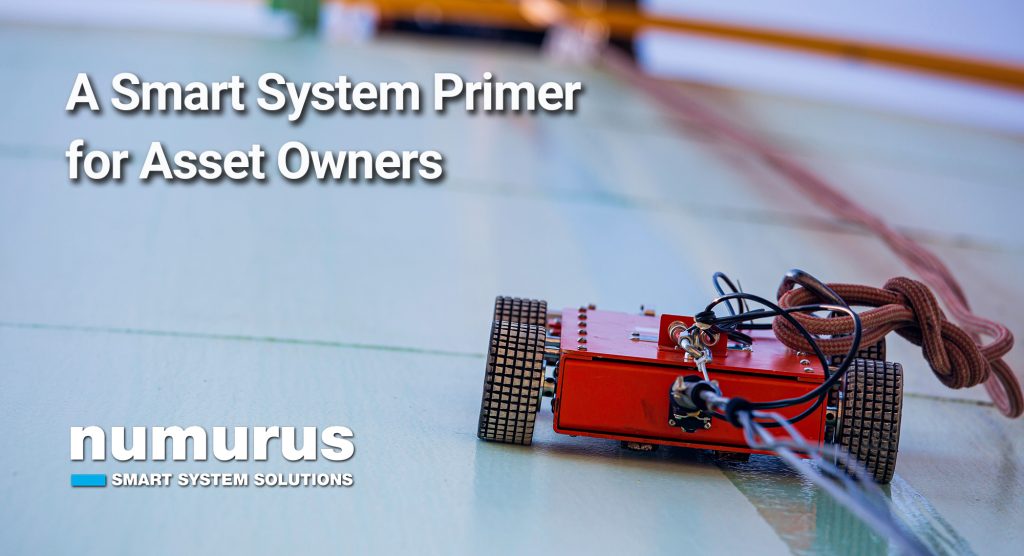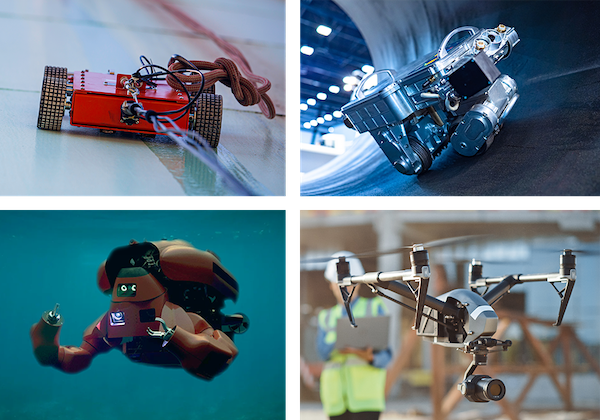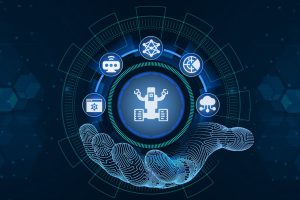
A Smart System Primer for Asset Owners
An Inside Look at Smart System Capabilities, Applications, Benefits, Implementation Challenges, and Solutions
OVERVIEW

Industries have plenty to gain by increasing their automation, use of robotics and artificial intelligence for in-field operations. In the energy sector alone, “Automation has become an increasingly important tool for energy professionals, enabling them to increase efficiency, reduce costs, and gain a better understanding of their operations.”1 In agriculture, “AI, machine learning (ML) and the IoT sensors that provide real-time data for algorithms increase agricultural efficiencies, improve crop yields and reduce food production
costs,”2 said Louis Columbus, Forbes Contributing Editor. These opportunities are evident in many more industries, but asset owners must identify those that both move the needle and quickly create and demonstrate value. At the heart of these opportunities are very complex technologies so it is not surprising that many asset owners feel perplexed when ‘more automation’ or ‘AI’ is on their roadmap for improved, safer, in-field inspection and maintenance operations.
As asset owners look to employ more in-field automation, smart systems with new capabilities are required to enable the rapid adoption of such solutions across a wide array of operational needs. While traditional inspection and maintenance involves human interaction at all stages of the process including data collection, interpretation, and distribution, in-field smart system solutions typically require the automation of each of these processes to achieve desired results. By integrating AI and other edge processes, along with Internet of Things (IoT) interfacing, smart systems reduce the time and costs to create application-specific robotic inspection and maintenance products that deliver real-time information to both local and remote information consumers.
This white paper arms asset owners with concepts and processes that allow them to meet these challenges, gain clarity, and successfully implement in-field inspection and maintenance automation improvements.
WHAT ARE SMART SYSTEMS?
 Smart systems advance in-field operational capabilities by adding edge AI, robotics, and remote connectivity to traditional sensor technologies. Smart systems provide organizations with actionable information and are helping to automate inspection and maintenance operations in a broad range of industries. The key advantage of smart systems is their ability to process data into information in real-time and that information to downstream consumers such as robotic control systems and remote operations management personnel.
Smart systems advance in-field operational capabilities by adding edge AI, robotics, and remote connectivity to traditional sensor technologies. Smart systems provide organizations with actionable information and are helping to automate inspection and maintenance operations in a broad range of industries. The key advantage of smart systems is their ability to process data into information in real-time and that information to downstream consumers such as robotic control systems and remote operations management personnel.
A typical smart system combines sensing, data localization, analytics, artificial intelligence, and communications, along with technician level management features to achieve in-field automation and reduce dependency on humans-in-the-loop operations. “Organizations are expected to automate industrial processes owing to the significant risk management and inefficiency of conventional processes,” 3 according to the authors of an article in Sensors. The key advantage of smart systems is they put the information requirements at the heart of the system design. This differs from the more common practice of bolting a variety of independent sensor and processing packages together that ultimately produces terabytes of raw data that is nearly impossible to derive actionable information.
SMART SYSTEMS – BENEFITS FOR ASSET OWNERS
The benefits of implementing smart systems for asset inspection and maintenance range from merely staying competitive enough to preserve existing markets to potential quantum leaps in net profit.
 Reduce Costs
Reduce Costs
Smart systems avoid high cost by first applying a fusion of ‘good-enough’ sensors that can give much more robust information at a lower cost. Smart systems also offer a lower-cost inspection system by combining sensing, processing, and deployment capabilities in one integrated package. This reduces the need for large vehicles, a multitude of housings, and the cabling system required to connect every together. A McKinsey and Company report states that companies that have digitized and automated their maintenance processes now show a significant increase in labor productivity and a 20 to 30 percent reduction in maintenance costs.4
 Expand Services
Expand Services
Many companies started and grew based on being the best performance option in the market, always adding features and capabilities to keep up with the competition. While this process is generally required to maintain current market share, it does little towards opening new markets. In general, smart systems offer a unique way to break into new markets by optimizing performance to a specific application’s needs, which minimizes system size and costs. Organizations relying solely on incremental product improvements to existing products to stay ahead of the competition are significantly limiting their future growth potential.
 Improve Decision Making
Improve Decision Making
Better decisions can be made when the real-time data from smart systems is delivered, processed and produced into actionable information. “With automated processes, companies can analyze data, obtain valuable insights, and gain improved visibility of their production sites’ performance, helping them make data-driven decisions,”5 stated Lian Jye Su in a Robotics Business Review post.
 Stay Competitive
Stay Competitive
According to an Accenture study that surveyed 250 asset management executives, “95% of the respondents believe that an asset manager’s technology, data and digital capabilities will be differentiators in 2025.”6 The increasing use of smart system emerging technologies, like visual AI, IoT, ML, drivers and interfaces will produce market leaders. Those who stay ahead of the technology and adopt smart systems in their operations will be ahead of the competition while delivering improved services to their end-customers.
CHALLENGES ASSET OWNERS FACE
 In many mid-to-large organizations, there are a handful of barriers that stall or completely block the adaption of disruptive technologies making it difficult for these organizations to stay relevant and competitive over the long run.
In many mid-to-large organizations, there are a handful of barriers that stall or completely block the adaption of disruptive technologies making it difficult for these organizations to stay relevant and competitive over the long run.
While the technical components of smart systems are not trivial, in many cases, it is an organization’s hesitation to change that limits the wide-spread adoption of smart system inspection and maintenance solutions. These obstacles are not new, and are evident in every new disruptive technology that promises to upend an organization’s normal way of business. There are several areas of organizational resistance to disruptive technologies:
 Fear of Change
Fear of Change
One of the most effective ways to motivate employees to accept change is through transparent employee communications. The communications need to convey what the change is, why the change is important for the future growth of the company and how new career opportunities and skills advancement opportunities will be created to support the pivot. “Open communication from leadership on the status of the transformation and its implications for day-to-day work are particularly closed linked with transformation success,”7 according to the authors of a McKinsey Report.
 Fear of Job Loss
Fear of Job Loss
With many organizations’ revenue and profit based on billed service hours, efficiency can be seen as a threat. The fear of job loss due to more robotics is real and should be addressed. Employees should be encouraged to see the efficiencies gained as force multipliers. For example, if a service that required five personnel using a manual inspection technique can now be done with one person plus one smart system, then this five-person team should be able to service five times the business with the same overhead. If the markets you are working in cannot support that type of business growth, then you can use the extra personnel and smart systems to open adjacent markets, and communicate this opportunity with employees.
 Lack of Adequate Investment
Lack of Adequate Investment
Many organizations will rubberstamp a project that is considered a requirement to maintain current sales, but then question every dollar and decision related to a new business endeavor. The over-focus on short term revenue forecasts versus the long-term growth opportunities disruptive technologies like smart systems offer is a challenge. While it is true that dollars spent to enhance an existing product can produce short term bumps in revenue, they typically don’t have long-term, needle changing results.
 Organization Structure Investment
Organization Structure Investment
Organizations must be willing to setup teams based on longer term business opportunities and give those teams some autonomy to react to market needs as they become better understood. Engineering development should be focused on rapid iterations and quick deployment of new products rather than creating the perfect product from the outset. With the rapid deployment approach customer feedback on early products will quickly guide the improvements needed to create winning solutions. Disruptive product sales teams should include technical sales-oriented individuals that can work with customers to define business goals and plans related to these new capabilities.
CONCLUSION
Smart Systems put the information requirement at the heart of system design and use a combination of edge artificial intelligence, sensors, automation scripts, interfaces and drivers to support that information requirement. Implementing smart systems into operations may come with some resistance and organizational challenges. These challenges can be overcome with a clear strategy, strong employee communications and executive level willingness to support longterm growth. Asset owners who employ smart systems will have the opportunity to experience the success they aspire to achieve.
ABOUT THE AUTHOR
 Jason Seawall CEO at Numurus LLC
Jason Seawall CEO at Numurus LLC
Jason Seawall is an expert in the fields of advanced automation, robotics and sensing drawing upon over 20 years of experience. Jason was a research engineer at both the Applied Research Laboratory in Texas and the Applied Physics Laboratory in Washington working on robotic sensors for defense applications. He founded and sold BlueView, a marine robotic sensor company to Teledyne in 2012 and took the role of VP of Technology in Teledyne’s marine robotics and sensing division. In 2017, Jason co-founded Numurus to focus on products that accelerate the development of autonomous robotic systems.
Contact
Want to learn more about Numurus and Smart System Solutions? Please contact us:
 info@numurus.com
info@numurus.com
 www.numurus.com
www.numurus.com
 Linkedin/numurus
Linkedin/numurus

1 Breaking Energy News, How the Energy Sector Can Take Advantage of Automation, Feb, 2023. 2 Forbes, 10 Way AI Has the Potential to Improve Agriculture, Feb, 2021, Louis Columbus. 3 MDPI, Machine Learning-Enabled Smart Industrial Automation Systems Using Internet of Things, Sensors, Oct, 2022. 4 McKinsey, The Future of Maintenance for Distributed Fixed Assets, June, 2020. 5 Robotics Business Review, Edge ML and Robotics Critical for Digitalization and Industrial Automation Initiatives. Lian Jye Su. 6 Accenture, The Future of Asset Management, Business Models and Strategies for 2025, May, 2021, Page 3. 7 McKinsey, The Future of Maintenance for Distributed Fixed Assets, June, 2020.
© 2023 Numurus LLC


